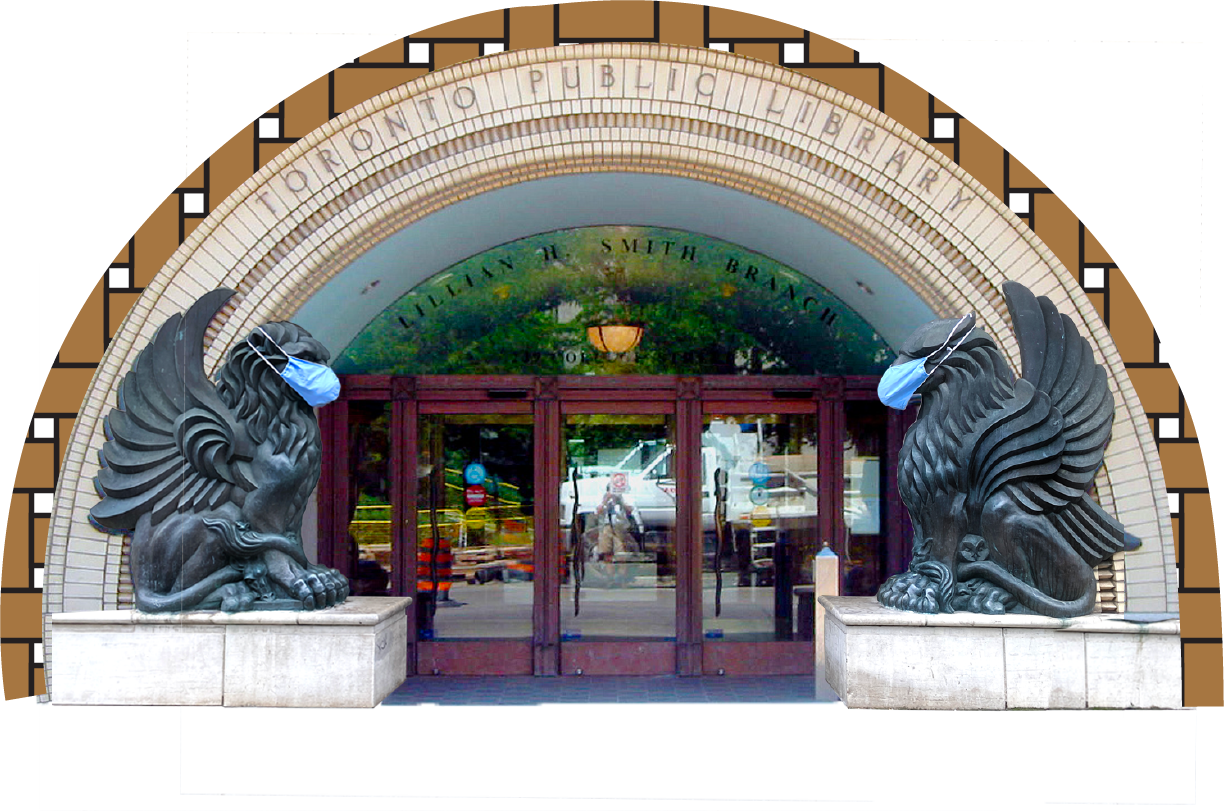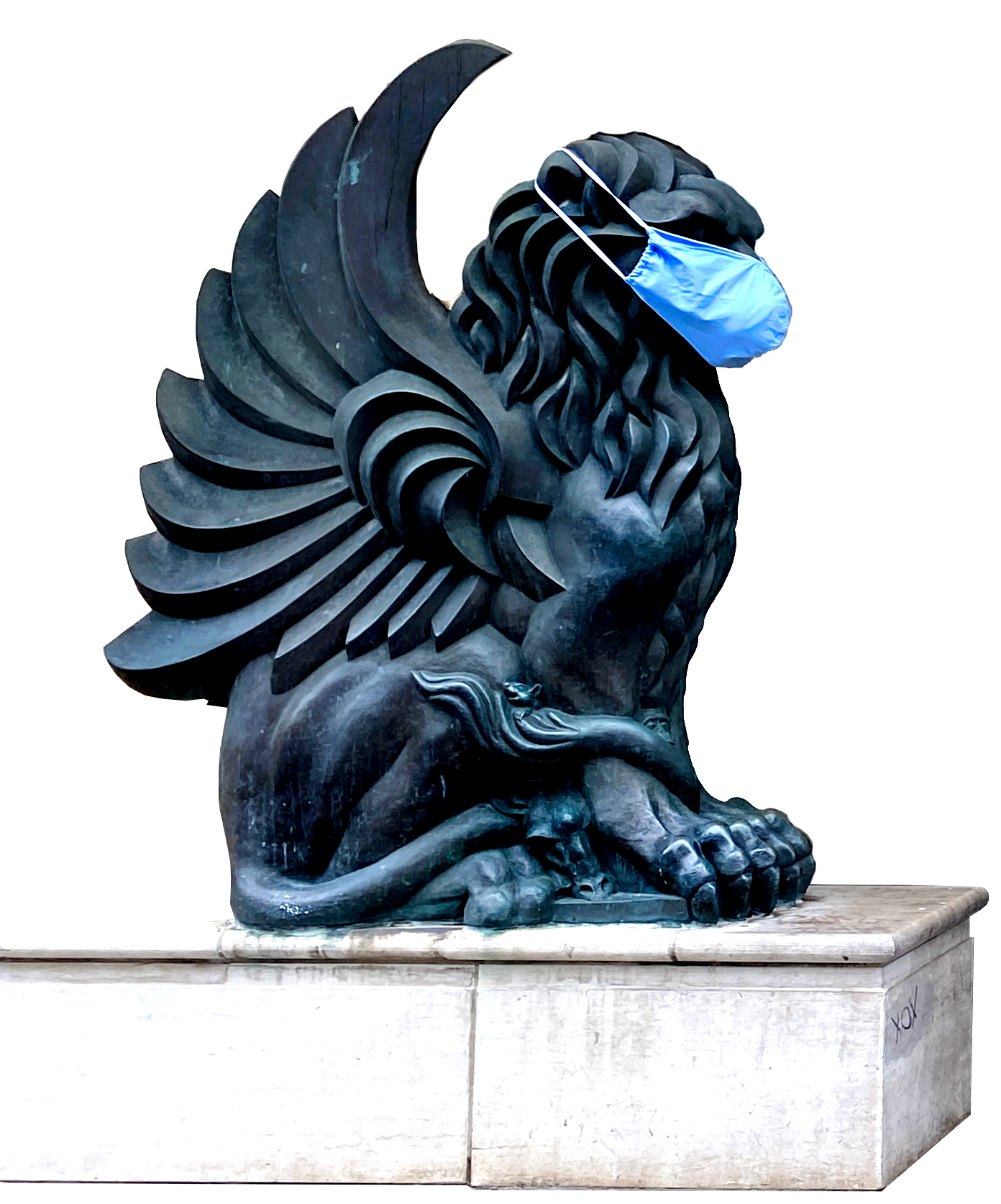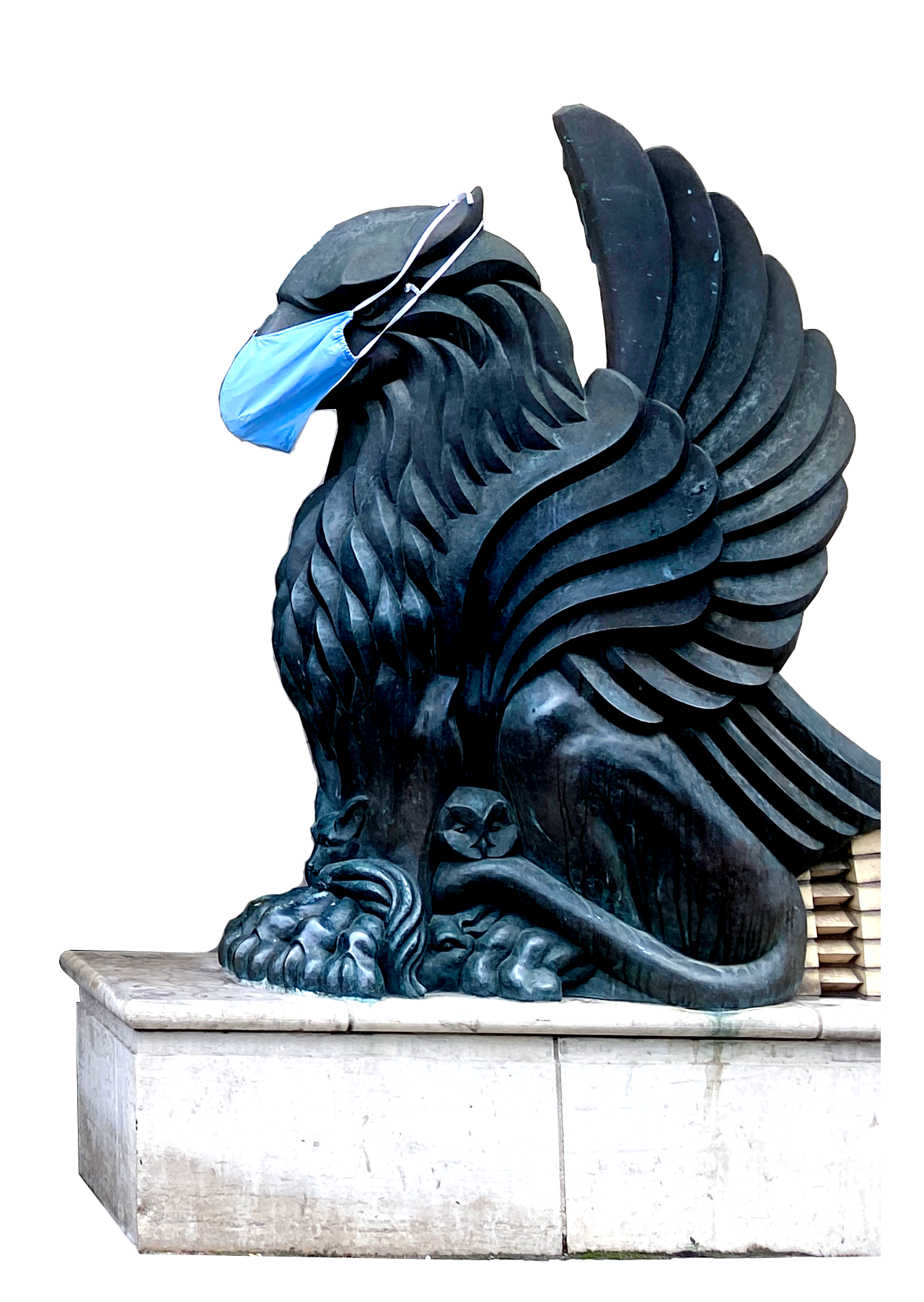 Do Canadians even know what we want from a library?
Do Canadians even know what we want from a library?
by Christine Sismondo
Like everybody, Judith and Edgar started wearing masks this summer. For decades, the duo has guarded the entrance to Toronto Public Library’s bustling Lillian H. Smith branch on College St, dutifully greeting waves of patrons.
Judith and Edgar’s masks are special, however — custom-made, measuring two square feet in order to cover the faces of these two 3,000 kilogram, eight-foot-tall bronze griffins. These watchful beasts allude to the world of fantasy and adventure housed just beyond them, in the branch’s legendary children’s collection. But the guardians also represent the lofty, mythic tasks charged to our public libraries, more apparent than ever as they model good mask etiquette. But it’s one thing to dress our fantastic creatures up for the occasion. Actually moving these megaliths in any way proves much more difficult — even with those beautiful wings.
Off-book
Like the griffins, many public library workers had no trouble masking up and buckling down during this health crisis. Libraries across Canada have re-invented themselves according to their mandate to serve the community’s needs. How? By offering curbside pick-up, enhanced online programming, virtual story times, and Black Lives Matter reading groups.
But library staff also know they are uniquely positioned to reach people in need. When nearly everything shuttered, libraries shifted their focus to direct aid — shelter for people experiencing homelessness, nutritious food for people facing food insecurity, referrals to services.
Why? Well, libraries have been building these relationships and doing this work for decades. In an effort to give access to all, many have developed infrastructure to offer a lot more than just books and movies. Moose Jaw’s library offers an Asperger’s peer support group that won a national award for accessibility; the architects of Halifax’s eco-friendly central library spent five years consulting with the Mi’kmaq community and African Nova Scotians to ensure the space would welcome underserved groups; and, in Toronto, the Parkdale library’s ESL program helped turn an empty lot into the Milky Way community garden, where the area’s Tibetan newcomers grow otherwise scarce ingredients that are crucial to their foodways.
There are thousands more innovative, off-book services in libraries across Canada. Books, magazines, and newspapers are central to the service and identity of the public library. But these progressive outreach programs expand their service to include supporting vulnerable communities who access the spaces. By and large, Canadians cherish libraries and their sense of duty. And we have never expected more from them.
A space for all?
 You might say big libraries are having a moment. New or transformed flagship branches have popped up in cities across Canada — Winnipeg, Scarborough, Vancouver, Calgary, to name a few. But these sleek modernist fortresses aren’t without troubles. Austerity politicians love to zero in, like Alberta’s Jason Kenney, who put library funding “on hold” last year. Others who have suggested budget cuts, citing the internet (that’s free to all, right?) and those cute front-yard book exchange boxes.
You might say big libraries are having a moment. New or transformed flagship branches have popped up in cities across Canada — Winnipeg, Scarborough, Vancouver, Calgary, to name a few. But these sleek modernist fortresses aren’t without troubles. Austerity politicians love to zero in, like Alberta’s Jason Kenney, who put library funding “on hold” last year. Others who have suggested budget cuts, citing the internet (that’s free to all, right?) and those cute front-yard book exchange boxes.
Not all problems come from politicians. In the past year, both Vancouver and Toronto public libraries have come under fire for allowing Meghan Murphy, a trans-exclusionary radical feminist (TERF) accused of propagating hate speech, to use their public room rental services.
“The Meghan Murphy incident is a by-product of a very problematic room rental policy in which libraries will distance themselves and say, ‘this person does not represent our values or views; we are simply a neutral platform,’” explains Jane Schmidt, a librarian at Ryerson University. “Setting aside the notion of whether or not libraries even should be neutral, the whole notion of whether they could be neutral is absurd. The whole idea of neutrality, itself, is problematic.”
Your feelings about the decision to rent space to Murphy might depend on whether or not you believe TERF rhetoric qualifies as hate speech, which would fall into “restricted speech” under the Canadian Charter of Rights and Freedoms. It also probably depends on whether or not you think “de-platforming” (literally the act of denying someone a certain platform when that person is accused of spewing hate) is the same as censorship.
Schmidt notes that libraries have faced similar scrutiny over renting to far-right hate groups. In July 2017, the Richview branch of the Toronto Public Library refused to cancel a memorial for lawyer Barbara Kulaszka, who defended holocaust deniers, white supremacists, and alleged Nazi war criminals. The event was hosted by Canada’s most infamous white supremacist, Paul
Fromm. The American Library Association (ALA) publicly re-visited their policies that same summer, in the wake of the violent Unite the Right rally in Charlottesville, Virginia. Turns out, library rooms are often used by hate groups for their meetings, too. After a year of careful thought, the ALA explicitly revised its Library Bill of Rights — an important document designed to protect users’ privacy as well as freedom of expression — to allow hate groups access to space.
Not all libraries have caved to extremists or shielded themselves behind a decidedly loose definition of freedom of expression. In 2017, the Ottawa Public Library cancelled a screening of Killing Europe in response to the film’s emphatic Islamophobia. The organizers sued. As of now, two levels of courts have upheld the library’s right not to show the film, deeming it an “exercise of discretion.” However, no rulings have fully delved into the issue of hate speech itself, so stay tuned for more litigation — if not over this, another incident. The prospect of a splashy trial over freedom of expression within the public sphere that amplifies the hate groups’ message is likely one of the reasons many extremists choose libraries in the first place.
Librarians, then, must choose between public outrage or a potential lawsuit. It’s an unenviable position, but in Toronto, they’ve bungled this dilemma with increasingly public gusto. Earlier this year, trans activist Jill Dilts used a Freedom of Information request to obtain and release 191 pages of the library’s internal emails and memos surrounding the Murphy affair. The documents paint an ugly picture of upper level librarians, particularly, City Librarian Vickery Bowles. In one message, Toronto City Manager Chris Murray sounds unimpressed, inquiring just how the event could be reconciled with a policy that excludes rentals to anyone “promoting discrimination, contempt or hatred.” Instead of stopping to reconsider the case, the library hastily started working on a communications plan to cover their asses.
“PEOPLE HAVE VERY HIGHFALUTIN IDEAS ABOUT LIBRARIES… IN GENERAL, WE ARE TRYING TO OFFER SUPPORT TO THOSE WITH FEWER RESOURCES.”
Murray’s question is a good one: How is it possible that the library, seen by many as a bastion of progressivism, is seemingly siding with the alt-right? Well, despite all the hard-working staff supporting all kinds of vulnerable groups, there’s a reactionary backbone to the library system. Turns out a better question might be “Why don’t things like this happen more often?”
An ugly past
Most people credit the beginning of the modern public library to Andrew Carnegie, the American steel baron philanthropist who financed more than 2,500 libraries circa 1883-1929. Although Carnegie’s influence is better known in the United States, 125 Carnegie libraries were also built in Canada.
Carnegie is rightly celebrated as a generous philanthropist. He was also a total bastard. He used violent Pinkerton mercenaries to quash labour movements and gave a lot of cash to the Anti-Saloon League, a prominent prohibitionist lobby organization linked to the Ku Klux Klan, whose policy victories laid the foundation for the brutally racist, anti-poor drug laws that remain in place today. Libraries were a part of this vision, thought of as tools to “civilize” immigrants from southern and eastern Europe. They were also intended to be alternatives to the ubiquitous saloons, which were, at the time, hotbeds of union organizing and political militants.
Still, institutions can evolve, right? Surely Carnegie would not have approved of the Canadian libraries that installed safe disposal bins for used needles. The way libraries are designed can be redefined and reshaped by the staff and patrons who use them.
But deep change is challenging when the funding is coming from the government and, increasingly, donations from banks and corporate partners. Neither party is likely to fund radical initiatives. A perhaps even more difficult obstacle to overcome, however, are the white settler assumptions “baked into” the systems and principles that govern libraries.
The library institution was essentially established to promote cultural assimilation, literacy, the superiority of the English language, and silence — as opposed to dissent. Not only do hundreds of First Nations, Métis, and Inuit communities in Canada not have physical library spaces, but only recently has librarianship begun to acknowledge the exclusion of oral history within institutions that thrive on literacy. New initiatives, such as the First Nations Circle built at Halifax Central Library, aim to reconcile this reality.
These problems aren’t unique to the library. All public spaces billed as an agora for the exchange of ideas appear accessible and egalitarian to the people who can access it, but there are often imperceptible limits. These limits might include proof of address and proper identification to get a membership, an inability to pay late fees or, simply, being refused admittance by the patrol who works with Judith and Edgar to guard the treasure.
Some of these limits are imposed by stakeholders like management, who often want prestige, good publicity, and funding. And of course, these goals don’t always align with many workers in the system who would love to see libraries truly live up to their potential as spaces where social justice ideals can be achieved and lived on a day-to-day basis.
Which public? Whose library?
 And then there are the people who use them. Some just want a safe and accessible space to look for jobs and housing on the internet or to quietly read a book without being harassed by TERFs. When the public weighs in, sometimes it is to insist that the library should be a home for radical freedom of expression, not considering the historical impacts or limits of “freedom.” Other times, it is to object that the library shouldn’t be for “ideological indoctrination,” or fun, in the case of the wildly successful Drag Queen Story Time program that, in five years, has grown from a single event in San Francisco to an international organization with 40 chapters.
And then there are the people who use them. Some just want a safe and accessible space to look for jobs and housing on the internet or to quietly read a book without being harassed by TERFs. When the public weighs in, sometimes it is to insist that the library should be a home for radical freedom of expression, not considering the historical impacts or limits of “freedom.” Other times, it is to object that the library shouldn’t be for “ideological indoctrination,” or fun, in the case of the wildly successful Drag Queen Story Time program that, in five years, has grown from a single event in San Francisco to an international organization with 40 chapters.
Last year, at a library branch in Ottawa, an anti-LGBTQ protester burst into Drag Queen Story Hour yelling that l the attendees, children and all, would be “cast into a lake of fire.” These things happen on occasion. On the other hand, Douglas Davey, children’s librarian at Halton Hills Public Library, says criticism at his branch has been minimal and that the Drag Queen Story Time was the most popular drop-in program ever launched. “It’s not necessarily the same in all parts of Canada,” he adds.
“Some people have very highfalutin ideas about libraries which are not always borne out,” Davey says, “In general, we are always trying to make our communities better and … support those with fewer resources.” We spoke to a half-dozen librarians who told us about so many surprising and creative initiatives, which range from late-fee amnesty programs to free recording studio access to installing charging stations in exterior spaces so people can stay plugged in during off-hours. In Moose Jaw, librarian Tina Dolcetti made it her personal mission to make sure currents reached outdoor electrical outlets throughout the pandemic — a model for a librarian action figure with a removable cape if there ever was one.
“We tend to be a group of introverts who want to help,” Davey says.
It shouldn’t come as a surprise that a public institution, even one with shiny magical griffins out front, has a problematic past, fraught with paradoxes and contradictions. Nor should it raise eyebrows that there are contemporary tensions and complicated negotiations to be made over how to serve the community — especially one that gets its funding from wealthy private donors and the government. That’s the nature of public life.
If it can be done at all, though, it will surely be those introverted helpers and the committed community members who will ultimately help the library live up to its aspirational ideals as a space that truly serves the public —whoever that is..
And Judith and Edgar, of course. They have a role to play, too.
